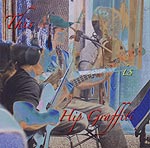
Top of the Heap
|
This review first appeared in Turbula in May 2005.
In their publicity materials, Hip Graffiti makes the rather less-than-breathless claim to be "one of Oceanside's premier jazz bands." Well, such ostentatious claims can hardly go unchallenged – even if, as we suspect, it turns out that Hip Graffiti is the only jazz band in Oceanside, Calif.
A couple listens to their new CD, "This Is Hip Graffiti," offers enough evidence to suggest that the band might want to nudge their publicist to raise the bar a tad. Truth is, this is one of the best jazz bands in the San Diego region – and in our jazz-rich environment, that's saying something.
Guitarist Jay Myerson and vocalist Carol Fuller provide a rich yet accessible sound for Hip Graffiti's run through standards and lesser-known chestnuts. The small rhythm section of bassist Wendy Hrehovcsik and percussionist Warren Bryant lay down a smooth but solid foundation for Myerson and Fuller to play atop.
Stylistically, Hip Graffiti is a contemporary straight-ahead band with traces of Brazilian and R&B. Myerson plays a hollow-body guitar; it's got that patented fat sound, but with a bit of an edge to it – closer to Barney Kessel than George Benson.
Fuller's voice sounds a bit on the thin side at times here, but she's spot-on in terms of timing and technique.
The play list ranges from the tried-and-true ("I Get a Kick (Out of You)," "A Foggy Day," "Stella by Starlight") to Brazil's Antonio Carlos Jobim ("Corcovado," "Vivo Sonhando," "Meditation") to some unfamiliar treats ("Softly As in a Morning Sunrise," Djavan's "Flor de Lis"). The approach in each case is respectful but not reverential; these are songs to be played, not museum pieces to be worshipped.

